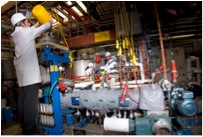
Pretreatment Methods for Biomass Conversion into Biofuels and Biopolymers
National Renewable Energy Laboratory
Contact NREL About This Technology
Technology Marketing SummaryHydrolysis of lignocellulosic biomass using an acid catalyst to produce sugars has been known for decades but can be costly and requires special equipment. The hydrolyzed sugars themselves are somewhat labile to the harsh hydrolysis conditions and may be degraded to unwanted or toxic byproducts. If exposed to acid for too long, the glucose derived from cellulose degrades into hydroxymethlylfurfural, which can be further degraded into levulinic acid and formic acid. Xylose, a hemicellulose sugar, can be degraded into furfural and further to tars and other degradation products.
After a century of research and development, the dilute acid hydrolysis process has evolved into a highly efficient process of converting biomass into ethanol. Hydrolysis occurs in two stages to maximize sugar yields from the hemicellulose and cellulose fractions of biomass. The first stage is operated under milder conditions to hydrolyze hemicellulose, while the second stage is optimized to hydrolyze the more resistant cellulose fraction. Liquid hydrolyzates are recovered from each stage, neutralized, and fermented to ethanol.DescriptionPatents: 6,660,506, 6,423,145, 6,228,177 and 5,705,369
This technology is a set of processes to convert lignocellulosic biomass to ethanol, comprising hydrolyzing lignocellulosic materials by subjecting dried lignocellulosic material in a reactor to a catalyst composed of a dilute solution of a strong acid and a metal salt to lower the activation energy (i.e., the temperature) of cellulose hydrolysis and ultimately obtain higher sugar yields. The lower temperatures achieved reduces the need for costly steam and specialized equipment and enables the hydrolysis of both hemicellulose and cellulose, when used with hydrolyzer feeders that do not compact the biomass feedstock to achieve higher sugar yields. The liquid hydrolyzates are recovered from each stage and fermented to alcohol. Residual cellulose and lignin left over in the solids from the hydrolysis reactors serve as boiler fuel for electricity or steam production.
Patent: 6,022,419
A multi-function process for hydrolysis and fractionation of lignocellulosic biomass to separate hemicellulosic sugars from other biomass components.BenefitsNREL’s intellectual property in the area of pretreatment, can be beneficial to your company’s pretreatment steps in a number of ways, including the following:
-Lower required activation temperature for hydrolysis of both hemicelluloses and cellulose can reduce the cost of steam and equipment
-Increase fermentable sugar yields
-Recover water soluble sugars
-Requires less sever pH, temperature, and time than conventional prehydrolysis.
-Greater extraction of cellulose and hemicelluloses
- reduced nutrient requirements
- fermentation method in 00-52 eliminates the need for washing the second-stage hydrolysate to recover soluble sugars.
-Requires a less severe combination of pH, temperature, and time than conventional prehydrolysis.Applications and IndustriesBio-fuels
Pulp & paper
Food & Feed processing
Textile processesPatents and Patent Applications
Technology Status
After a century of research and development, the dilute acid hydrolysis process has evolved into a highly efficient process of converting biomass into ethanol. Hydrolysis occurs in two stages to maximize sugar yields from the hemicellulose and cellulose fractions of biomass. The first stage is operated under milder conditions to hydrolyze hemicellulose, while the second stage is optimized to hydrolyze the more resistant cellulose fraction. Liquid hydrolyzates are recovered from each stage, neutralized, and fermented to ethanol.DescriptionPatents: 6,660,506, 6,423,145, 6,228,177 and 5,705,369
This technology is a set of processes to convert lignocellulosic biomass to ethanol, comprising hydrolyzing lignocellulosic materials by subjecting dried lignocellulosic material in a reactor to a catalyst composed of a dilute solution of a strong acid and a metal salt to lower the activation energy (i.e., the temperature) of cellulose hydrolysis and ultimately obtain higher sugar yields. The lower temperatures achieved reduces the need for costly steam and specialized equipment and enables the hydrolysis of both hemicellulose and cellulose, when used with hydrolyzer feeders that do not compact the biomass feedstock to achieve higher sugar yields. The liquid hydrolyzates are recovered from each stage and fermented to alcohol. Residual cellulose and lignin left over in the solids from the hydrolysis reactors serve as boiler fuel for electricity or steam production.
Patent: 6,022,419
A multi-function process for hydrolysis and fractionation of lignocellulosic biomass to separate hemicellulosic sugars from other biomass components.BenefitsNREL’s intellectual property in the area of pretreatment, can be beneficial to your company’s pretreatment steps in a number of ways, including the following:
-Lower required activation temperature for hydrolysis of both hemicelluloses and cellulose can reduce the cost of steam and equipment
-Increase fermentable sugar yields
-Recover water soluble sugars
-Requires less sever pH, temperature, and time than conventional prehydrolysis.
-Greater extraction of cellulose and hemicelluloses
- reduced nutrient requirements
- fermentation method in 00-52 eliminates the need for washing the second-stage hydrolysate to recover soluble sugars.
-Requires a less severe combination of pH, temperature, and time than conventional prehydrolysis.Applications and IndustriesBio-fuels
Pulp & paper
Food & Feed processing
Textile processesPatents and Patent Applications
ID Number |
Title and Abstract | Primary Lab |
Date |
|---|---|---|---|
Patent 5,705,369 |
Prehydrolysis of lignocellulose
The invention relates to the prehydrolysis of lignocellulose by passing an acidic or alkaline solution through solid lignocellulosic particles with removal of soluble components as they are formed. The technique permits a less severe combination of pH, temperature and time than conventional prehydrolysis. Furthermore, greater extraction of both hemicellulose and lignin occurs simultaneously in the same reactor and under the same conditions. |
National Renewable Energy Laboratory | 01/06/1998
Issued |
Patent 6,022,419 |
Hydrolysis and fractionation of lignocellulosic biomass
A multi-function process is described for the hydrolysis and fractionation of lignocellulosic biomass to separate hemicellulosic sugars from other biomass components such as extractives and proteins; a portion of the solubilized lignin; cellulose; glucose derived from cellulose; and insoluble lignin from said biomass comprising one or more of the following: optionally, as function 1, introducing a dilute acid of pH 1.0-5.0 into a continual shrinking bed reactor containing a lignocellulosic biomass material at a temperature of about 94 to about 160.degree. C. for a period of about 10 to about 120 minutes at a volumetric flow rate of about 1 to about 5 reactor volumes to effect solubilization of extractives, lignin, and protein by keeping the solid to liquid ratio constant throughout the solubilization process; as function 2, introducing a dilute acid of pH 1.0-5.0, either as virgin acid or an acidic stream from another function, into a continual shrinking bed reactor containing either fresh biomass or the partially fractionated lignocellulosic biomass material from function 1 at a temperature of about 94-220.degree. C. for a period of about 10 to about 60 minutes at a volumetric flow rate of about 1 to about 5 reactor volumes to effect solubilization of hemicellulosic sugars, semisoluble sugars and other compounds, and amorphous glucans by keeping the solid to liquid ratio constant throughout the solubilization process; as function 3, optionally, introducing a dilute acid of pH 1.0-5.0 either as virgin acid or an acidic stream from another function, into a continual shrinking bed reactor containing the partially fractionated lignocellulosic biomass material from function 2 at a temperature of about 180-280.degree. C. for a period of about 10 to about 60 minutes at a volumetric flow rate of 1 to about 5 reactor volumes to effect solubilization of cellulosic sugars by keeping the solid to liquid ratio constant throughout the solubilization process; and as function 4, optionally, introducing a dilute acid of pH 1.0-5.0 either as virgin acid or an acidic stream from another function, into a continual shrinking bed reactor containing the partially fractionated lignocellulosic biomass material from function 3 at a temperature of about 180-280.degree. C. for a period of about 10 to about 60 minutes at a volumetric flow rate of about 1 to about 5 reactor volumes to effect solubilization of cellulosic sugars by keeping the solid to liquid ratio constant throughout the solubilization process. |
National Renewable Energy Laboratory | 02/08/2000
Issued |
Patent 6,228,177 |
Aqueous fractionation of biomass based on novel carbohydrate hydrolysis kinetics
A multi-function process for hydrolysis and fractionation of lignocellulosic biomass to separate hemicellulosic sugars from other biomass components comprising extractives and proteins; a portion of a solubilized lignin; cellulose; glucose derived from cellulose; and insoluble lignin from said biomass comprising: a) introducing either solid fresh biomass or partially fractioned lignocellulosic biomass material with entrained acid or water into a reactor and heating to a temperature of up to about 185.degree. C.-205.degree. C. b) allowing the reaction to proceed to a point where about 60% of the hemicellulose has been hydrolyzed in the case of water or complete dissolution in case of acid; c) adding a dilute acid liquid at a pH below about 5 at a temperature of up to about 205.degree. C. for a period ranging from about 5 to about 10 minutes; to hydrolyze the remaining 40% of hemicellulose if water is used. d) quenching the reaction at a temperature of up to about 140.degree. C. to quench all degradation and hydrolysis reactions; and e) introducing into said reaction chamber and simultaneously removing from said reaction chamber, a volumetric flow rate of dilute acid at a temperature of up to about 140.degree. C. to wash out the majority of the solubilized biomass components, to obtain improved hemicellosic sugar yields. |
National Renewable Energy Laboratory | 05/08/2001
Issued |
Patent 6,423,145 |
Dilute acid/metal salt hydrolysis of lignocellulosics
A modified dilute acid method of hydrolyzing the cellulose and hemicellulose in lignocellulosic material under conditions to obtain higher overall fermentable sugar yields than is obtainable using dilute acid alone, comprising: impregnating a lignocellulosic feedstock with a mixture of an amount of aqueous solution of a dilute acid catalyst and a metal salt catalyst sufficient to provide higher overall fermentable sugar yields than is obtainable when hydrolyzing with dilute acid alone; loading the impregnated lignocellulosic feedstock into a reactor and heating for a sufficient period of time to hydrolyze substantially all of the hemicellulose and greater than 45% of the cellulose to water soluble sugars; and recovering the water soluble sugars. |
National Renewable Energy Laboratory | 07/23/2002
Issued |
Patent 6,660,506 |
Ethanol production with dilute acid hydrolysis using partially dried lignocellulosics
A process of converting lignocellulosic biomass to ethanol, comprising hydrolyzing lignocellulosic materials by subjecting dried lignocellulosic material in a reactor to a catalyst comprised of a dilute solution of a strong acid and a metal salt to lower the activation energy (i.e., the temperature) of cellulose hydrolysis and ultimately obtain higher sugar yields. |
National Renewable Energy Laboratory | 12/09/2003
Issued |
Development Stage | Availability | Published | Last Updated |
|---|---|---|---|
| Development | Available | 01/14/2010 | 07/16/2010 |


